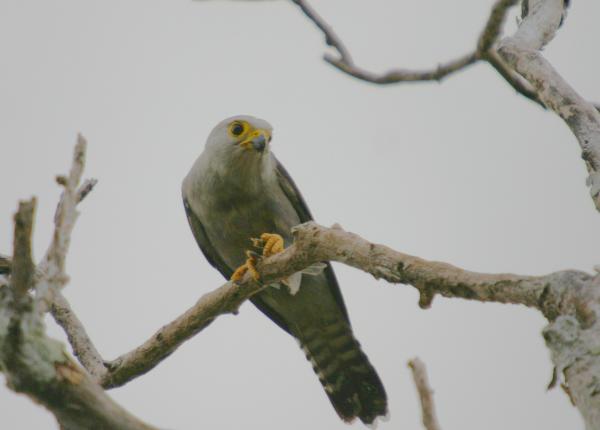Did You Know?
- Dickinson's Kestrel is also known as the White-rumped Kestrel
- Unlike other kestrels, the Dickinson's Kestrel rarely or never hovers.
- This kestrel has been observed pirating, or stealing, food from a Gabar Goshawk!
How The Peregrine Fund is Helping
Though The Peregrine Fund does not work directly with Dickinson's Kestrels, our efforts in scientific research, habitat conservation, education, and community development help conserve birds of prey around the world. We also supply literature to researchers from our avian research library, which helps scientists around the world gather and share important information on raptor conservation. And, finally, our support of the Global Raptor Information Network gives raptor researchers tools to more efficiently conduct their own studies while contributing to a global program. It also provides citizen scientists a way to participate in raptor science and conservation.
Where They Live
The Dickinson's Kestrel is found throughout a large area within sub-Saharan Africa. It makes its home in a variety of habitats including woodlands, open areas such as grasslands and lightly wooded areas, savannas, areas with clusters of tall palm trees or baobabs, and even in coconut plantations. It seems to prefer habitat that has many exposed perches and very little ground cover. It is often found in habitats close to water.
What They Do
This raptor spends a lot of time on on exposed perches, particularly outside of breeding season. It is a solitary falcon, either seen by itself or in pairs. If you are in Dickinson's Kestrel territory, be sure to look alongside roads, where it likes to perch. Its flight has been described as being choppy and, when it lands, it sometimes prefers to first cling to the trunk of a tree rather than land directly on a branch.
Why They Need Our Help
Dickinson's Kestrel is categorized as a species of Least Concern, which means conservationists aren't very worried about the future of this lovely kestrel. In fact, it is considered generally common in some portion of its range, particularly in savannas with plentiful palm trees. However, the species has experienced some population declines in some areas, but thankfully some really good habitat remains, particularly in national parks, which means this habitat should be protected for a long time.
What They Eat
Like many other kestrel species, the Dickinson's Kestrel has a varied diet that includes rodents, lizards, small birds, frogs, crustaceans, and insects, such as beetles, locusts, and a praying mantis. It often swoops down on its prey from a perch, capturing it on the ground. It might also capture prey after an aerial pursuit.
This species seeks out fires in grasslands in brushy areas, as this is a good opportunity for it to capture insects and small animals that are fleeing the smoke and flames. Researchers have also documented this kestrel following farm equipment for similar reasons - large tractors and other equipment often scare up insects, birds, and other small animals.
Nests, Eggs, and Young
Like most other falcons, this kestrel doesn't build its own nest. It prefers instead to nest in holes in trees, such as baobab trees. It might lay its eggs in the tops of dead palm stumps, old Hammerkop nests, and even on man-made structures such as bridges. The female will lay 2-4 eggs, which are off-white and decorated with reddish or brown smears or spots.
Once the eggs are laid, the female will take on the job of incubating and otherwise caring for her eggs. She will sit on them almost constantly to make sure they are safe and at just the right temperature for the young fetuses to develop into healthy hatchlings. She will do this for around 30 days! During this time, the male is busy hunting, hunting, hunting! He must be able to capture enough food to feed himself, the female, and, once they hatch, his nestlings. After the nestlings do hatch, they will stay in the nest for another 30-35 days until they are ready to fly from the nest for the first time!
Dickinson's Kestrel and the World Center for Birds of Prey
Though The World Center for Birds of Prey is quite far from the Dickinson's Kestrel's range, it is still a wonderful place to learn about birds of prey, and even other kestrel species! Come to the World Center for Birds of Prey and meet an American Kestrel up close, examine kestrel feathers at the touch table, and compare the size of a kestrel egg with that of an ostrich. If you walk the interpretive nature trail to the gazebo overlooking the Boise Valley, you are likely to see a kestrel hovering over the sage in search of prey or, if you are lucky, a young bird just learning to fly.
References:
Global Raptor Information Network. 2021. Species account: Dickinson's Kestrel Falco dickinsoni. Downloaded from http://www.globalraptors.org on 29 Nov. 2021
Kemp, A. C. and G. M. Kirwan (2020). Dickinson's Kestrel (Falco dickinsoni), version 1.0. In Birds of the World (J. del Hoyo, A. Elliott, J. Sargatal, D. A. Christie, and E. de Juana, Editors). Cornell Lab of Ornithology, Ithaca, NY, USA. https://doi.org/10.2173/bow.dickes1.01









